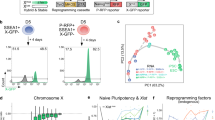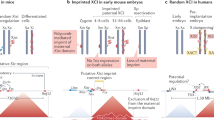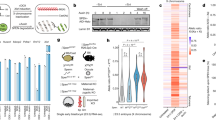Abstract
In eukaryotes transcriptional regulation often involves multiple long-range elements and is influenced by the genomic environment1. A prime example of this concerns the mouse X-inactivation centre (Xic), which orchestrates the initiation of X-chromosome inactivation (XCI) by controlling the expression of the non-protein-coding Xist transcript. The extent of Xic sequences required for the proper regulation of Xist remains unknown. Here we use chromosome conformation capture carbon-copy (5C)2 and super-resolution microscopy to analyse the spatial organization of a 4.5-megabases (Mb) region including Xist. We discover a series of discrete 200-kilobase to 1 Mb topologically associating domains (TADs), present both before and after cell differentiation and on the active and inactive X. TADs align with, but do not rely on, several domain-wide features of the epigenome, such as H3K27me3 or H3K9me2 blocks and lamina-associated domains. TADs also align with coordinately regulated gene clusters. Disruption of a TAD boundary causes ectopic chromosomal contacts and long-range transcriptional misregulation. The Xist/Tsix sense/antisense unit illustrates how TADs enable the spatial segregation of oppositely regulated chromosomal neighbourhoods, with the respective promoters of Xist and Tsix lying in adjacent TADs, each containing their known positive regulators. We identify a novel distal regulatory region of Tsix within its TAD, which produces a long intervening RNA, Linx. In addition to uncovering a new principle of cis-regulatory architecture of mammalian chromosomes, our study sets the stage for the full genetic dissection of the X-inactivation centre.
This is a preview of subscription content, access via your institution
Access options
Subscribe to this journal
Receive 51 print issues and online access
$199.00 per year
only $3.90 per issue
Buy this article
- Purchase on SpringerLink
- Instant access to full article PDF
Prices may be subject to local taxes which are calculated during checkout





Similar content being viewed by others
References
Kleinjan, D. A. & Lettice, L. A. Long-range gene control and genetic disease. Adv. Genet. 61, 339–388 (2008)
Dostie, J. et al. Chromosome conformation capture carbon copy (5C): a massively parallel solution for mapping interactions between genomic elements. Genome Res. 16, 1299–1309 (2006)
Rastan, S. Non-random X-chromosome inactivation in mouse X-autosome translocation embryos–location of the inactivation centre. J. Embryol. Exp. Morphol. 78, 1–22 (1983)
Rastan, S. & Robertson, E. J. X-chromosome deletions in embryo-derived (EK) cell lines associated with lack of X-chromosome inactivation. J. Embryol. Exp. Morphol. 90, 379–388 (1985)
Augui, S., Nora, E. P. & Heard, E. Regulation of X-chromosome inactivation by the X-inactivation centre. Nature Rev. Genet. 12, 429–442 (2011)
Anguera, M. C. et al. Tsx produces a long noncoding RNA and has general functions in the germline, stem cells, and brain. PLoS Genet. 7, e1002248 (2011)
Heard, E., Mongelard, F., Arnaud, D. & Avner, P. Xist yeast artificial chromosome transgenes function as X-inactivation centers only in multicopy arrays and not as single copies. Mol. Cell. Biol. 19, 3156–3156 (1999)
Lieberman-Aiden, E. et al. Comprehensive mapping of long-range interactions reveals folding principles of the human genome. Science 326, 289–293 (2009)
Marks, H. et al. High-resolution analysis of epigenetic changes associated with X inactivation. Genome Res. 19, 1361–1373 (2009)
Pauler, F. M. et al. H3K27me3 forms BLOCs over silent genes and intergenic regions and specifies a histone banding pattern on a mouse autosomal chromosome. Genome Res. 19, 221–233 (2009)
Wen, B., Wu, H., Shinkai, Y., Irizarry, R. A. & Feinberg, A. P. Large histone H3 lysine 9 dimethylated chromatin blocks distinguish differentiated from embryonic stem cells. Nature Genet. 41, 246–250 (2009)
Lienert, F. et al. Genomic prevalence of heterochromatic H3K9me2 and transcription do not discriminate pluripotent from terminally differentiated cells. PLoS Genet. 7, e1002090 (2011)
Hawkins, R. D. et al. Distinct epigenomic landscapes of pluripotent and lineage-committed human cells. Cell Stem Cell 6, 479–491 (2010)
Rougeulle, C. et al. Differential histone H3 Lys-9 and Lys-27 methylation profiles on the X chromosome. Mol. Cell. Biol. 24, 5475–5484 (2004)
Montgomery, N. D. et al. The murine polycomb group protein Eed is required for global histone H3 lysine-27 methylation. Curr. Biol. 15, 942–947 (2005)
Monkhorst, K., Jonkers, I., Rentmeester, E., Grosveld, F. & Gribnau, J. X Inactivation counting and choice is a stochastic process: evidence for involvement of an X-linked activator. Cell 132, 410–421 (2008)
Spencer, R. J. et al. A boundary element between Tsix and Xist binds the chromatin insulator Ctcf and contributes to initiation of X chromosome inactivation. GeneticsCrossRef (2011)
Kagey, M. H. et al. Mediator and cohesin connect gene expression and chromatin architecture. Nature 467, 430–435 (2010)
Peric-Hupkes, D. et al. Molecular maps of the reorganization of genome-nuclear lamina interactions during differentiation. Mol. Cell 38, 603–613 (2010)
Splinter, E. et al. The inactive X chromosome adopts a unique three-dimensional conformation that is dependent on Xist RNA. Genes Dev. 25, 1371–1383 (2011)
Caron, H. et al. The human transcriptome map: clustering of highly expressed genes in chromosomal domains. Science 291, 1289–1292 (2001)
Tsai, C.-L., Rowntree, R. K., Cohen, D. E. & Lee, J. T. Higher order chromatin structure at the X-inactivation center via looping DNA. Dev. Biol. 319, 416–425 (2008)
Heard, E. et al. Transgenic mice carrying an Xist-containing YAC. Hum. Mol. Genet. 5, 441–450 (1996)
Guttman, M. et al. Chromatin signature reveals over a thousand highly conserved large non-coding RNAs in mammals. Nature 458, 223–227 (2009)
Khalil, A. M. et al. Many human large intergenic noncoding RNAs associate with chromatin-modifying complexes and affect gene expression. Proc. Natl Acad. Sci. USA 106, 11667–11672 (2009)
Seidl, C. I. M., Stricker, S. H. & Barlow, D. P. The imprinted Air ncRNA is an atypical RNAPII transcript that evades splicing and escapes nuclear export. EMBO J. 25, 3565–3575 (2006)
Ruf, S. et al. Large-scale analysis of the regulatory architecture of the mouse genome with a transposon-associated sensor. Nature Genet. 43, 379–386 (2011)
Kikuta, H. et al. Genomic regulatory blocks encompass multiple neighboring genes and maintain conserved synteny in vertebrates. Genome Res. 17, 545–555 (2007)
Dixon, J. R. et al. Topological domains in mammalian genomes identified by analysis of chromatin interactions. Nature 10.1038/nature11082 (this issue)
Sexton, T. et al. Three-dimensional folding and functional organization principles of the Drosophila genome. Cell 148, 458–472 (2012)
Mercier, R. et al. The MatP/matS site-specific system organizes the terminus region of the E. coli chromosome into a macrodomain. Cell 135, 475–485 (2008)
Acknowledgements
We thank T. Pollex and T. Forné for experimental help; the imaging facility PICTIBiSA@BDD for technical assistance, D. Gentien and C. Hego for microarray hybridizations. We thank K. Bernhard, F. Stewart and A. Smith for protocols and material for 2i culture and EpiSC differentiation. We are grateful to members of the E.H. laboratory for critical input. This work was funded by grants from the Ministère de la Recherche et de l’Enseignement Supérieur and the ARC (to E.P.N.); a HFSP Long term fellowship (LT000597/2010-L) (to E.G.S.). EU EpiGeneSys FP7 Network of Excellence no. 257082, the Fondation pour la Recherche Medicale, ANR, ERC Advanced Investigator award no. 250367 and EU FP7 SYBOSS grant no. 242129 (to E.H.). N.B. was supported by BMBF (FORSYS) and EMBO (fellowship ASTF 307-2011). J.D., B.R.L. and N.L.v.B. were supported by NIH (R01 HG003143) and a W. M. Keck Foundation Distinguished Young Scholar Award.
Author information
Authors and Affiliations
Contributions
E.P.N. performed and analysed 3C, 5C, (RT–)qPCR, immunofluorescence, RNA and DNA FISH. B.R.L. and N.L.v.B. helped in the design and/or the analysis of 3C and 5C. L.G. performed 3C, FISH and 5C analysis. E.G.S. generated the time-course transcriptomic data, which was analysed by J.M. and N.B.; I.O. performed FISH on pre-implantation embryos. J.G. donated the XTX mouse ESC line. N.S. and E.B. helped in the epigenomic and 5C analyses. J.S. and T.P. set up OMX microscopy and analysis and T.P. performed structured illumination microscopy and image analysis. The manuscript was written by E.P.N., J.D. and E.H. with contribution from E.G.S. and input from all authors.
Corresponding authors
Ethics declarations
Competing interests
The authors declare no competing financial interests.
Supplementary information
Supplementary Information
This file contains Supplementary Figures 1-15, Supplementary Methods and additional references. (PDF 10774 kb)
Supplementary Data 1
This file contains mapped 5C counts. (ZIP 8192 kb)
Supplementary Data 2
This file contains intraTAD 5C peaks. (ZIP 510 kb)
Supplementary Table 1
This file contains 5C Oligos and restriction Fragment. (XLS 562 kb)
Supplementary Table 2
This file contains cDNA microarrays. (XLS 382 kb)
Supplementary Table 3
This file contains the sequencing log. (XLS 57 kb)
Supplementary Table 4
This file contains qPCR Primers. (XLS 12 kb)
Rights and permissions
About this article
Cite this article
Nora, E., Lajoie, B., Schulz, E. et al. Spatial partitioning of the regulatory landscape of the X-inactivation centre. Nature 485, 381–385 (2012). https://doi.org/10.1038/nature11049
Received:
Accepted:
Published:
Issue Date:
DOI: https://doi.org/10.1038/nature11049



